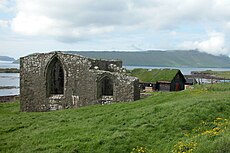
The Church of Iceland, officially the Evangelical Lutheran Church of Iceland, is the national church of Iceland. The church is Christian and professes the Lutheran faith. It is a member of the Lutheran World Federation, the Porvoo Communion, the Communion of Protestant Churches in Europe, and the World Council of Churches.
Nidaros, Niðarós or Niðaróss was the medieval name of Trondheim when it was the capital of Norway's first Christian kings. It was named for its position at the mouth of the River Nid.
This is a timeline of Faroese history comprising important legal and territorial changes and political events in Iceland and its predecessor states. To read about the background to these events, see history of the Faroe Islands.

Olsok is a national day of celebration on July 29 in the Nordic countries of Norway and the Faroe Islands, and also in the provinces of Härjedalen in Sweden and Savonlinna in Finland.
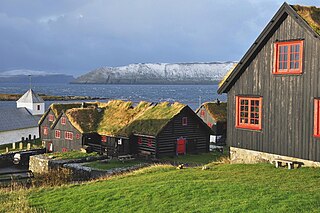
Kirkjubøur is the southernmost village on Streymoy, Faroe Islands. The village is located on the south-west coast of Streymoy and has a view towards the islands of Hestur and Koltur towards the west, and to Sandoy towards the south. It lies south of the new ferry port of Gamlarætt, which opened in 1993.

Religion in the Faroe Islands is dominated by the Lutheran Christianity. Historically linked to both Norway and Denmark, the islands' religious evolution reflects a blend of Norse traditions and Danish influences. Although the Lutheran Church remains predominant, the islands also host an array of other religious groups, including smaller Protestant denominations, Catholics, and followers of non-Trinitarian religions.

Kirkjubøargarður is one of the oldest still inhabited wooden houses in the world, if not the oldest. The farm itself has always been the largest in the Faroe Islands.

The Diocese of Lund is a diocese within the Church of Sweden which corresponds to the provinces of Blekinge and Skåne. There are 217 parishes within the diocese, the most significant number in any of the dioceses of the Church of Sweden. The present bishop of Lund, Johan Tyrberg, succeeded Antje Jackelén in 2014.

The Catholic Church in the Faroe Islands goes back to the year 999, when king Olav Tryggvason of Norway sent Sigmundur Brestisson on a mission to the islands with several priests. The islands became an independent diocese in 1111, but were officially reformed in 1537 and the last Catholic bishop was executed in 1538. After 1538, the Catholic Church was only revived in 1931 as a part of the bishopric of Copenhagen. The state church is now the Protestant Faroese People's Church.
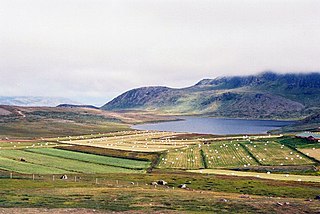
Garðar was the seat of the bishop in the Norse settlements in Greenland. It is a Latin Catholic titular see, and was the first Catholic diocese established in the Americas.

The former Diocese of Odense was a Roman Catholic diocese in Denmark which included the islands of Funen, Langeland, Tåsinge, Lolland, Falster, Als, and Ærø. Its episcopal see was located in Odense at St. Canute's Cathedral.

The Church of the Faroe Islands is one of the smallest state churches in the world. Prior to becoming independent on 29 July 2007, it was a diocese of the Church of Denmark, a Lutheran church. As of 2023, 77.0% of the Faroe Islanders belonged to the state church.

The Archdiocese of Nidaros was the metropolitan see covering Norway in the later Middle Ages. The see was the Nidaros Cathedral, in the city of Nidaros. The archdiocese existed from the middle of the twelfth century until the Protestant Reformation.
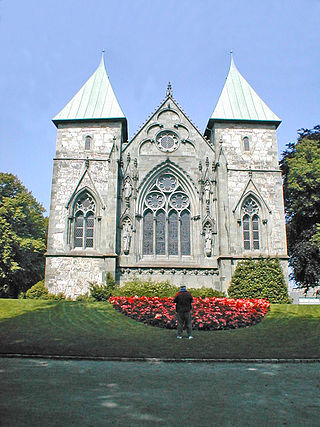
The former Catholic Diocese of Stavanger in Norway included the modern counties of Rogaland and Agder together with the regions of Valdres and Hallingdal and the parishes of Eidfjord and Røldal from Hordaland. It existed from the beginning of the 12th century to the Protestant Reformation.
The Catholic Diocese of Bergen or Diocese of Bjørgvin in Norway existed from the eleventh century to the Protestant Reformation (1537), and included the (modern) counties of Hordaland and Sogn og Fjordane.

Steinvikholm Castle is an island fortress on the Skatval peninsula near Stjørdal in Trøndelag county, Norway. The castle was built over seven years, from 1525 to 1532, by Norway's last Roman Catholic Archbishop, Olav Engelbrektsson. Steinvikholm castle became a powerful fortification by the time it was built, and it is the largest construction raised in the Norwegian middle age.
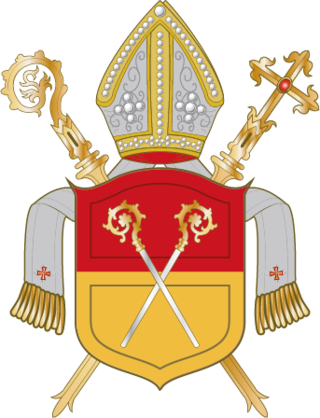
The Diocese and Prince-bishopric of Schwerin was a Catholic diocese in Schwerin, Mecklenburg, in Germany. The first registered bishop was ordained in the diocese in 1053, and the diocese ceased to exist in 1994.

Hoskuld Hoskuldsson was the 28th and last Roman Catholic Bishop of Stavanger, from 1513 until the Reformation in 1537, and also a member of the Riksråd.
The majority of the Greenlandic population is Christian and associates with the Church of Denmark via the Church of Greenland, which is Protestant in classification and Lutheran in orientation. The Church of Denmark is the established church through the Constitution of Denmark; this applies to all of the Kingdom of Denmark, except for the Faroe Islands, as the Church of the Faroe Islands became independent in 2007. But traditional Inuit spiritual beliefs remain strong in many of Greenland's remote communities.
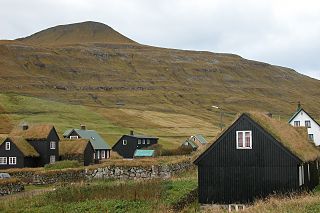
Heine Johnsøn Havreki (1514–1576) or Heine the shipwrecked was a Norwegian born-Icelandic Lutheran pastor who helped introduce the Protestant Reformation on the Faroe Islands.
